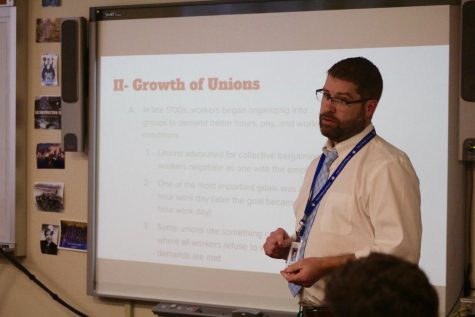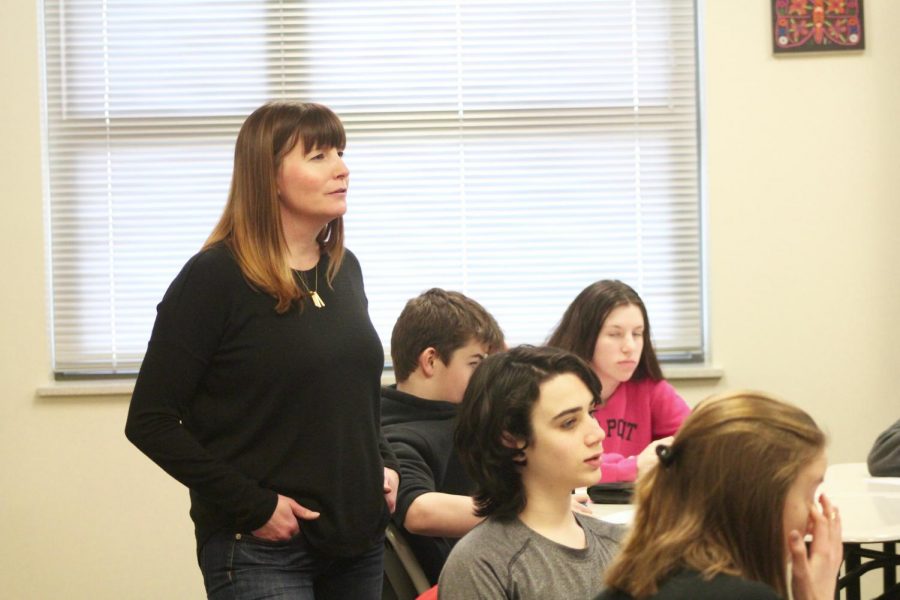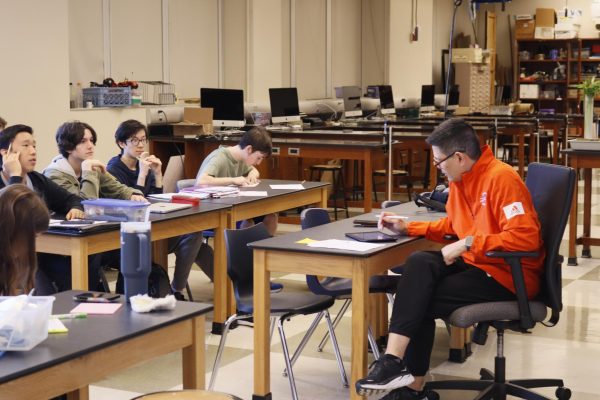Co-Teaching at Clayton
CHS history teachers Brooke Hartmann and Josh Meyers explain the advantages of their new co-teaching style
CHS history teacher Brooke Hartmann allows fellow history teacher Josh Meyers to present to their co-taught World/US History I class.
The benefits of shared leadership have been recognized in many aspects of American life. Planes are always flown by two pilots. Policemen work in pairs. Surgeons operate in groups. The gain of having more than one person doing a job has proved to be helpful in many careers. Now, two CHS history teachers, Josh Meyers and Ashley Hartmann, are piloting a co-teaching model for their freshman history classes.
“The idea was to attempt to differentiate as much as possible for a wide variety of learners, so with two content-specific teachers in the same classroom, the hope is to meet the needs of as many different students as possible,” Clayton Social Studies Coordinator Paul Hoelscher said.
The Clayton history department has tested variants of the co-teaching model in the past, but never with two content teachers. In fact, Meyers and Hartmann’s co-teaching model is one that has not been seen in any high schools across the nation.
“As far as we know, there aren’t models at the high school level where two content teachers from the same discipline are co-teaching,” Meyers said.
While the two have only been co-teaching together for six weeks, their students are already beginning to experience the benefits of co-teaching.
“One of the most important aspects of co-teaching is giving feedback. Research indicates that feedback for students ideally should be both timely and specific. It is difficult for one teacher to do both, but with two teachers in the room, it is easier. For example, during a class activity, one teacher can be leading the activity and another teacher can individually provide assistance to a student who needs redirection or feedback without the rest of the class losing steam or the student not getting their question answered. This opportunity is allowing us to put best [teaching] practice into action in an authentic way that benefits all students,” said Hartmann.
By having two teachers in the room, Hartmann and Meyers are able to cater to their students’ specific needs.
“We have the opportunities to do enrichment as well as remediation. It gives us an enormous amount of flexibility to meet the individualized needs of students,” Meyers said.
Furthermore, co-teaching allows teachers to see students’ reactions to information and allows teachers to make sure students are processing class material.
“When you’re teaching, you don’t always recognize [how students process instruction], but someone watching you can be like ‘Hey, call on someone different because I haven’t heard that person’s voice today,’” Hartmann said.
Beyond allowing students to learn and process at their own paces, co-teaching helps teachers improve and reflect on themselves.

CHS history teacher Josh Meyers presents in the freshman history class he co-teaches alongside history teacher Brooke Hartmann.
“I really like [co-teaching] because I like the built-in thinking partner that is with me every day. We sit in the office in the mornings and plan together for an hour or an hour and a half every single day, during lunch we debrief the lesson and assess what worked and what should be changed, at the beginning of each unit we discuss what data we want to collect and what skills to assess . . . I like being challenged to a certain degree about why I’m doing what I’m doing and talking through those processes. I think it’s something that reflective teachers do and can only benefit from to improve their practices,” Meyers said.
The biggest drawback when trying to implement a co-teaching model is the cost. Two teachers are being paid to teach one class.
“That’s an issue that has to be considered; having two teachers in a classroom means that your staffing costs are higher than if you were using a traditional non-co-taught model,” Meyers said.
After this year, Meyers and Hartmann are hoping to continue co-teaching at the freshman level.
“We’re hoping that we can do this again next year with freshman. It’s a tough transition to high school and freshmen benefit from getting direct immediate feedback from teachers that know the content,” Hartmann said.
Co-teaching could prove to be helpful in other disciplines as well as history.
“I could see how this could be beneficial in other classrooms like math and science where there is less understanding,” said freshman Kaitlyn Tran.
According to Meyers, co-teaching can additionally help to provide a more equal learning environment for all students.
“As the school continues to focus on equity work I think co-teaching is one way to try to provide more equitable experiences for students,” Meyers said.
A $50 or more donation includes a subscription to the Clayton High School Globe 2024-2025 print news magazine.
We will mail a copy of our issues to the recipients of your choice.
Your donation helps preserve the tangible experience of print journalism, ensuring that student voices reach our community and that student democracy thrives.

Sofia is a senior and is Editor-In-Chief of the Globe this year. She started Globe because she is interested in writing and exploring different issues in the Clayton community....






